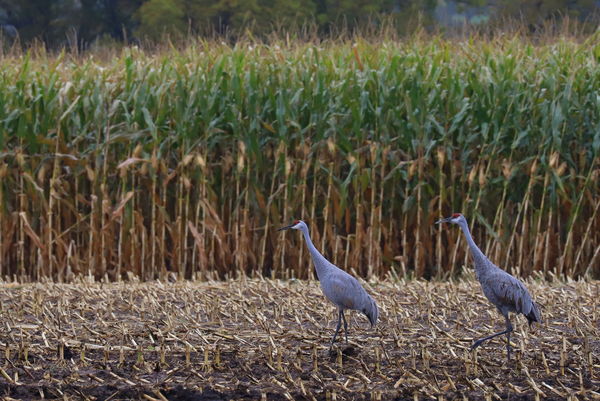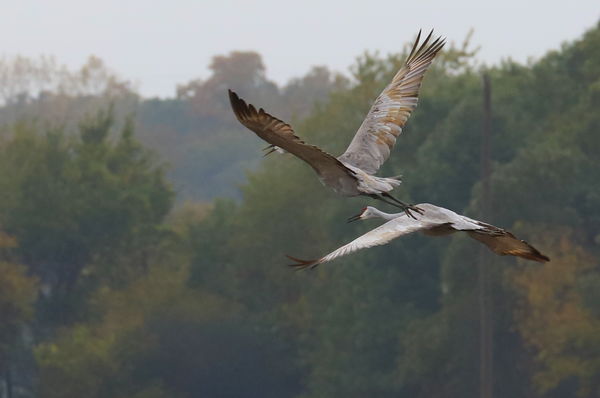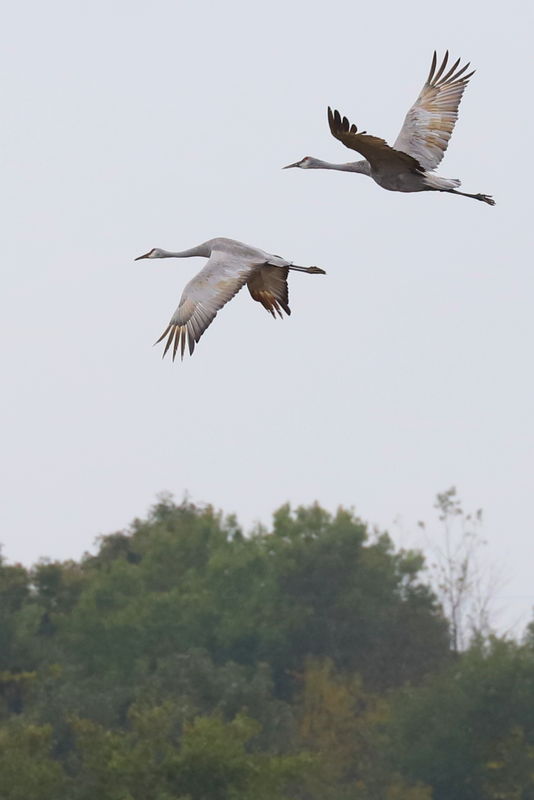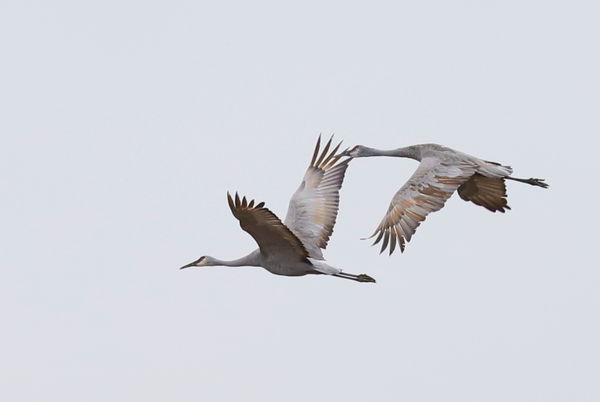BIF feedback appreciated
Oct 8, 2018 10:29:28 #
First post here and would like feedback, please.
Using Canon 6d mark II with Canon 100-400mm lens. BBF, Al Servo, High speed continuous, Spot meter, Single point AF, 1/800 shutter, f10, ISO 1600, hand held
Other than practice, any advice for improvement?
Using Canon 6d mark II with Canon 100-400mm lens. BBF, Al Servo, High speed continuous, Spot meter, Single point AF, 1/800 shutter, f10, ISO 1600, hand held
Other than practice, any advice for improvement?




Oct 8, 2018 10:41:37 #
With your camera/lens combo I would shoot wide open, lowest possible ISO, keep shutter up over 1/1000th whenever possible, Evaluative Metering but use exposure compensation for those situations needing compensation (you'll learn them if you shoot long enough), single focus point on birds on the ground, but use 5/9 when BIF.
As for the composition of the birds, try not to take pics of birds flying away, only birds flying perpendicular, or toward you for a more pleasing shot. Try not to keep those that have a wing in front of the other birds head or their own wing in front of their own head. Best pics of birds have a better sky not a grey sky. This just means going back on a better day. Bird photography is a lot of things. Not just taking a pic of a bird and calling it done. You want to look for the most pleasing background, wing position of the bird, eye always in focus and in view, sharp sharp sharp, good days with good light and nice skys with some clouds etc. All of this means going back and taking hundreds, if not thousands of pictures of one species of bird. I like the sandhill cranes a lot and I've got probably 5000 pics of them with about 10 keepers. I keep most of my pics, but I only show those that are exceptional (in my opinion). Keep practicing.
As for the composition of the birds, try not to take pics of birds flying away, only birds flying perpendicular, or toward you for a more pleasing shot. Try not to keep those that have a wing in front of the other birds head or their own wing in front of their own head. Best pics of birds have a better sky not a grey sky. This just means going back on a better day. Bird photography is a lot of things. Not just taking a pic of a bird and calling it done. You want to look for the most pleasing background, wing position of the bird, eye always in focus and in view, sharp sharp sharp, good days with good light and nice skys with some clouds etc. All of this means going back and taking hundreds, if not thousands of pictures of one species of bird. I like the sandhill cranes a lot and I've got probably 5000 pics of them with about 10 keepers. I keep most of my pics, but I only show those that are exceptional (in my opinion). Keep practicing.
Oct 8, 2018 11:09:02 #
dandev
Loc: Enumclaw, WA
Thanks Jeep Daddy. Question - what is the 5/9 focus points? I have a 5D3 and the 100-400.
Oct 8, 2018 11:17:28 #
jeep_daddy wrote:
With your camera/lens combo I would shoot wide ope... (show quote)
Thank you for your prompt and in-depth reply! I will apply your suggestions and keep on practicing
Oct 8, 2018 11:19:10 #
I would prefer that you store the original when posting examples so we can see the details of the images. I agree with the composition and sunny day aspects of Jeep's advice, earlier, but recommend not shooting wide open as a well-lit bird, flying toward the camera, in sunshine against a blue sky will also benefit from a depth of field that extends from the beak through the wing-tips and body. The two bottom examples seem to demonstrate this DOF, although the true details cannot be know from the thumbnail.
To get the best lighting, you should have the sun directly behind you with the birds flying at or toward you. I've found with cranes tend to fly from one feeding area to another along relatively straight lines, as individuals or in groups. If you have access to the same location, monitor the fields they use and their directions of travel and see if you can find a position in their path rather than along the side. I've also found they'll tend to follow a line of trees between fields which might afford you some cover when setting up in their path. If you can find an embankment so your head and shoulders and camera are the only portions raised above the ground level, this should help in not seeming to be a threat in their path.
Try the Zone AF for dynamic tracking, either the small 9-point cluster or the large zone, pages 139-140 of your 6D II manual. I prefer the smaller group working slightly off center, but it can be very hard to keep birds within the frame except when using the center points. I can spend 2- to 4-hours capturing images with only a few dozen worth keeping from 2000+ images, but practice via shooting, analyzing the results, identifying corrective actions in technique, and repeating the process, helps a lot in realizing tangible improvement over time. Bring multiple cards. Try to keep the focus cluster on their head and eye, if possible.
You can use shutter priority or aperture priority and manage the ISO to assure the 1/1000 and f/10 - f/13 aperture combination, or shoot in manual. Depending on the camera type, EC can be used to force the exposure to the right in auto ISO or you may need to actively manage the ISO yourself. You don't want the bird or sky blown out and blinking with highlight warnings, but +1 to +2 in Exposure Compensation is a usual setting needed for a light colored bird against a blue or overcast sky. This will minimize the noise from a higher ISO in the post processing. The lighting will change every 20-minutes or so, as well as when you pan across the sky so after a few birds fly by, regularly check your histogram and adjust, as needed, maybe even seeking to identify the point in the sky where you need to click a dial left or right as the lighting changes during a long panning motion.
To get the best lighting, you should have the sun directly behind you with the birds flying at or toward you. I've found with cranes tend to fly from one feeding area to another along relatively straight lines, as individuals or in groups. If you have access to the same location, monitor the fields they use and their directions of travel and see if you can find a position in their path rather than along the side. I've also found they'll tend to follow a line of trees between fields which might afford you some cover when setting up in their path. If you can find an embankment so your head and shoulders and camera are the only portions raised above the ground level, this should help in not seeming to be a threat in their path.
Try the Zone AF for dynamic tracking, either the small 9-point cluster or the large zone, pages 139-140 of your 6D II manual. I prefer the smaller group working slightly off center, but it can be very hard to keep birds within the frame except when using the center points. I can spend 2- to 4-hours capturing images with only a few dozen worth keeping from 2000+ images, but practice via shooting, analyzing the results, identifying corrective actions in technique, and repeating the process, helps a lot in realizing tangible improvement over time. Bring multiple cards. Try to keep the focus cluster on their head and eye, if possible.
You can use shutter priority or aperture priority and manage the ISO to assure the 1/1000 and f/10 - f/13 aperture combination, or shoot in manual. Depending on the camera type, EC can be used to force the exposure to the right in auto ISO or you may need to actively manage the ISO yourself. You don't want the bird or sky blown out and blinking with highlight warnings, but +1 to +2 in Exposure Compensation is a usual setting needed for a light colored bird against a blue or overcast sky. This will minimize the noise from a higher ISO in the post processing. The lighting will change every 20-minutes or so, as well as when you pan across the sky so after a few birds fly by, regularly check your histogram and adjust, as needed, maybe even seeking to identify the point in the sky where you need to click a dial left or right as the lighting changes during a long panning motion.
Oct 8, 2018 11:43:26 #
dandev wrote:
Thanks Jeep Daddy. Question - what is the 5/9 focus points? I have a 5D3 and the 100-400.
Either 5 or 9 focus points.
Oct 8, 2018 11:52:34 #
jeep_daddy wrote:
Either 5 or 9 focus points.
Dandev, see section 3 of your 5DIII manual, starting page 69. The Expanded Single Point (aka 5) is good if you have a steady consistent motion or a stationary object. The 9- or 12-point zones are better for more erratic subjects. If you can get a bird flying toward you and their head into the large box of either of the two zone configurations, and as long as you can keep the bird in the zone as you pan and follow the bird's flight, the EOS system will do a great job of keeping focus on the bird.
Oct 8, 2018 12:06:31 #
You might also consider auto iso. Birds fly through many differently lit areas as they go and auto iso can aid in keeping a fast shutter speed.
Oct 8, 2018 12:12:54 #
Oct 8, 2018 12:18:41 #
CHG_CANON wrote:
I would prefer that you store the original when po... (show quote)
Thank you for taking the time to reply and for offering so much added information!
Oct 9, 2018 19:22:24 #
Haymaker wrote:
First post here and would like feedback, please.
Using Canon 6d mark II with Canon 100-400mm lens. BBF, Al Servo, High speed continuous, Spot meter, Single point AF, 1/800 shutter, f10, ISO 1600, hand held
Other than practice, any advice for improvement?
Using Canon 6d mark II with Canon 100-400mm lens. BBF, Al Servo, High speed continuous, Spot meter, Single point AF, 1/800 shutter, f10, ISO 1600, hand held
Other than practice, any advice for improvement?
Pray for better light, train the birds to fly TOWARDS you 8-) , use a longer lens on full frame as the 6D does not crop well - use a camera with a higher frame rate ! With multiple birds, make sure to stop down a bit for DOF - or use a crop frame body with a shorter lens. BIF is the only time I recommend handholding.
..
Oct 11, 2018 08:34:33 #
imagemeister wrote:
Pray for better light, train the birds to fly TOWARDS you 8-) , use a longer lens on full frame as the 6D does not crop well - use a camera with a higher frame rate ! With multiple birds, make sure to stop down a bit for DOF - or use a crop frame body with a shorter lens. BIF is the only time I recommend handholding.
..
..
I will strive toward creating this best case scenario! Thanks for the tips

Oct 11, 2018 08:35:58 #
kpmac wrote:
You might also consider auto iso. Birds fly through many differently lit areas as they go and auto iso can aid in keeping a fast shutter speed.
Thank you for the suggestion.

If you want to reply, then register here. Registration is free and your account is created instantly, so you can post right away.




